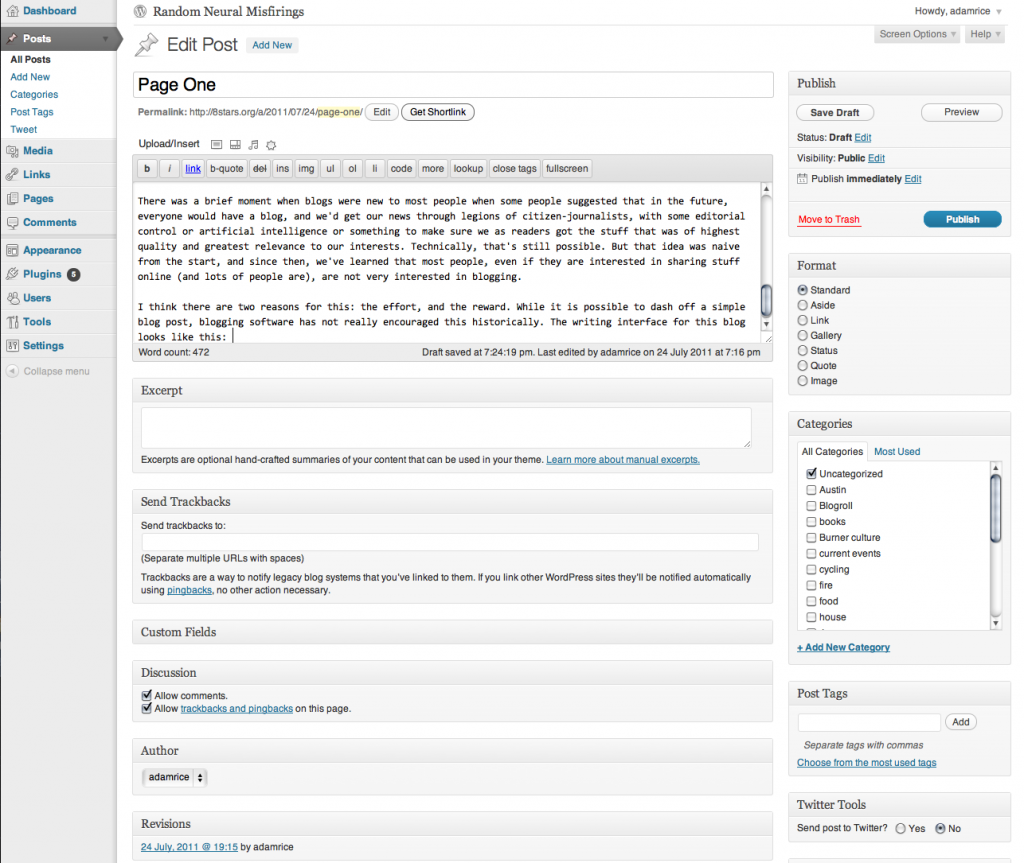Burning Flipside is a regional burn, an event in the spirit of Burning Man. It has been around since 1998 or 1999, depending on how you look at it. It’s grown a lot in numbers, and along with that, the organization that produces Flipside has grown in complexity and sophistication. My aim in this blog post is to describe that organization and how it works.
All volunteer
The first and most important point to make is that Flipside is an all-volunteer organization. No one gets paid to participate in Flipside. In fact, hardly anyone even gets a free ticket: every year, Flipside awards a pair of tickets to the winner of a ticket-design contest, another pair to the winner of a sticker-design contest. Those four tickets are the only free ones to Flipside. Everyone else pays full price for their tickets, including all the volunteers. Including the members of the board of directors (who serve on the board as volunteers).
Flipside does have outside vendors, of course. The companies that provide porta-potties, the heavy equipment, the ice, and so on at the event. Accountants. Lawyers. Landlords. Those people get paid. But they’re not participants at Flipside.
So Flipside is completely dependent on its participants stepping up and taking responsibility for making the event happen: Nothing “just happens” at Flipside–participants make it happen. Some of these volunteers need advanced skills and training–which in many cases they use in their everyday jobs–in order to discharge their volunteer responsibilities.
What does the organization do?
Flipside is a participatory art festival (among other things). The way we sometimes talk about is that if Flipside is a painting, the organization provides the frame and canvas, and the participants provide the paint.
So the organization provides infrastructure that makes the event possible. Participants independently make the event interesting.
What does the organization not do?
Lots of stuff.
Although Burning Man’s principle of “radical self-reliance” technically is not one of Flipside’s principles (Flipside has three principles in contrast to Burning Man’s ten) we are still big fans of that idea. Creative self-expression is one of our principles, and it ties in with the idea of self-reliance. Any time we consider adding something to Flipside, one of the questions we have to ask is whether we’re removing an incentive for someone else to be self-reliant and self-expressive in doing it on their own initiative. We also ask whether adding something will be too expensive, whether we would have enough volunteers for it, what unintended consequences it might have, and so on.
So with that explanation out of the way, Flipside as an organization doesn’t create any art projects except the Effigy. It does support and encourage other art projects, although it does not provide funds for them.
The organization doesn’t provide its participants with food or beverages or water or power. Or entertainment. Or shade structures. There are ideas offered under the “What can the community/organization do to make Flipside better?” section of this survey on Flipside 2013 that the organization will never undertake. They may be reasonable suggestions, but they would violate the spirit of self-reliance and self-expression. But the other side of that /, the community, can do (and in some cases has already done) lots of those ideas. There are other ideas that the organization might someday decide to do, but that someone else could do immediately, on their own initiative.
The organizational structure
Think of the Flipside organization as being shaped like a tree.
At the base of the tree is Austin Artistic Reconstruction, LLC (AAR). This is the board of directors. It it is the entity that has legal and financial responsibility for the event, as well as for the Warehouse. You can think of AAR as the membrane separating Flipside from default reality (whether that membrane is like a brick wall or like a soap bubble is an interesting question). Currently AAR has six members. Being a limited-liability company means that technically Flipside is not a non-profit, but it is not profit-oriented. None of the directors (Disclosure: I am one of them) make any money off of Flipside.
One branch coming up from that trunk is the Combustion Chamber (CC). This is an advisory body that discusses policy issues and community concerns. It also helps produce twice-yearly Town Halls and organizes a presence for the local Burner community on the East Austin Studio Tour.
CC meetings are usually every other Monday night at the Warehouse and are open to the public. Anyone can show up and say their piece (as long as it’s relevant to the topic under discussion). The CC currently has 14 members and periodically accepts nominations for new members. In terms of CC meetings, the only difference between CC members and the general public is that CC members can block resolutions (the CC operates on the consensus model).
Another set of branches coming up from the trunk are the Areas. And each of the areas has several Departments branching off of it. Each area is headed by an Area Facilitator; each department is headed by a Lead. In contrast to the CC, which focuses on policy, the areas and departments are operational. Some of the departments have only one person in them; some have dozens of volunteers. The number of areas has increased gradually over the years. The exact number of departments fluctuates from year to year, as some departments are inactivated and other are created or reactivated.
Sometimes its a little fuzzy as to whether a department belongs in one area or another, and there are a lot of tasks that wind up involving more than one department. It may look like a big bureaucracy, but we do a good job of making the organization serve the people rather than the other way around.
There are 9 areas:
360/24/7
This area handles year-round responsibilities–everything except Flipside.
Department leads: CC Scribes, Church Night Coordinator, Edjumication, Equipment Librarian, Off-Season Event Planning, Regional Outreach, Warehouse Manager.
Art
This area is mostly concerned with supporting art at Flipside and includes the Design and Fabrication Team (which builds the Effigy).
Department leads: Art Hype, Art Installation Logistics, Burn Night Coordinator, Burnable Art, Department of Mutant Vehicles, DaFT, Effigy Area Lighting, Graphic Arts, Procession Coordinator, Pyrotechnics, Regional Art Ambassador
City Planning
Organizes theme camps and places them–along with art and public spaces–on the map. Also, with greeters and zone greeters, helps welcome people into the city and get people to their camp sites.
Department leads: Cartography, City and Street Signage, Disinformation Kiosk, Flags/Camp Boundaries, Greeters Lead, InterZone Coordinator, Parks Department, Placement, Safety Lighting, Theme Camp Liaison
Communications
Another set of departments that are busy year-round, handling ticketing, the website, e-mail, etc.
Department leads: Content, Email Lists, Flipside Flame, Media Liaison, Sticket Design/Ordering, Survival Guide Lead, Ticket Distribution, Website Admin
Safety
The departments in this area are where some of those people with advanced skills and training that I was mentioning come into play.
Department leads: Boundaries and Safety Signage, Fire Safety Lead, Guardian (perimeter), PETs (Pyropolis Emergency Team, aka medics) Lead, Ranger Lead, Sanctuary, Sound Marshal
Site Ops
Handles most city infrastructure.
Department leads: Equipment Vendor Liaison, Power, Sanitation, Shaven Apes, Ice, Radio Communications, Pre-Ops, Transpo, Cartelle (motor pool), Fuel, Parking
Site Prep
Every year, there are several Work Weekends to get the event site ready for Flipside, clearing brush, laying roads (when needed), etc.
Department leads: Land Search, Roads, Waiver Wrangler, Work Weekend Communications, Work Weekend Tools and Supplies
Site Sign-off
We take Leave No Trace (LNT) very seriously at Flipside, and so we have a whole set of departments dedicated to it.
Department leads: Clean-up Lead, Earth Guardian Lead, Exodus, Post-Ops, Recycling Lead
Volunteer Coordinator
In addition to the above, Flipside has an additional Area Facilitator with no departments, the Volunteer Coordinator, who helps line up people who want to volunteer with departments that need volunteers.
Conclusion
That covers the structure of the organization. In the future, I may discuss individual areas in more detail. And I’d like to discuss the art projects and theme camps that make Flipside worthwhile.


